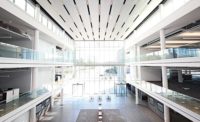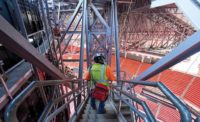The first week of April, Phoenix Motor Company opened the final half of its Mercedes-Benz of Scottsdale facility, 4725 N. Scottsdale Road, in the city’s burgeoning post-recession midtown.
On 5.12 infill acres at Highland Avenue, the $30-million adaptive-reuse project has recycled a 1983-vintage three-story office building and adjacent parking structure, Highland Park, into a contemporary green-intensive campus employing 100 sales, service and administrative staff.
The dealership comprises a majority of the original 92,500-sq-ft building, its adjacent 64,000-sq-ft two-level parking structure, and adds 20,000 sq ft of floor-to-ceiling glazed showroom space and climate-controlled interior service-drive area.
The initial western half of the steel-and-concrete dealership opened Dec. 30, 2013, just as the company closed and moved its long-time Phoenix Motor Company facility, Indian School and Third Avenue. This first phase includes the porcelain-floored new-car showroom, sales and administrative space, vehicle delivery center, service drive-in reception and service-bay areas, customer-lounge and café, an internal carwash and a vehicle-detail center.
The original Third Avenue and Indian School Road building opened in 1960, and the owners, the Theisen family, completed the current structure in 1985. That building is being sold. The 80-year-old company began offering Studebakers in Phoenix in 1934, and during this time, the agency also sold Rolls-Royce, Fiat, Peugeot, Alpine, Alfa Romeo, Mercedes-Benz and other brands.
The just-completed eastern half of Mercedes-Benz of Scottsdale adds more service bays, interior vehicle display and inventory areas. Total site parking includes 530 spaces, interior and exterior. Showroom display in the interior conditioned spaces is 188 new cars, including an area on the mezzanine for AMG-customized vehicles and a featured-car carousel on the west side.
Autopilot Development Services, a Scottsdale-based firm specializing in designing new and renovated space for car dealerships, provided the development management, the Tempe office of Johnson Carlier was the general contractor, Tempe-based Davis provided the overall design theme of the project, and Barry Barcus Associates, Phoenix, provided technical architectural support.
“One might consider this the ultimate ‘green–recycling’ project in which we have been able to effectively preserve the tired original office building and site infrastructure but upgraded to current energy-conservative and building code standards,” says Rick Cartell, president and founder of Autopilot. “That will effectively keep thousands of tons of perfectly good and reusable construction materials out of the landfill,” he adds.
A Crush on Green
The first and third floors and roof structures were entirely preserved, but the Johnson Carlier team raised the second floor of the original office building by approximately 3 ft to provide sufficient clearance for the vehicle service bays. Ramps were added to provide access from the street level.
“The existing columns stayed, but all of the steel beams had to be demo’ed and replaced,” he says. An attachment that became known as the “crusher” and “cruncher” was attached to the excavator for this steel-hewing work, Cartell says.
The original building atrium remains, allowing daylight into the 1.5-acre showroom display and inventory areas.
Incorporating a high level of LEED standards, the building embraces these principles without being submitted for certification.
“The owner didn’t want to go through the additional time, effort and expense of the process with the USGBC, although we think this could be LEED Silver, maybe even Gold,” Cartell explains, noting that the company’s Mercedes-Benz of Arrowhead attained LEED Silver eight years ago.
“Instead of getting LEED certification on this one, we just decided to incorporate those elements of the building that we thought would work particularly well here,” says Chuck Theisen, third-generation dealership owner, president and CEO. His wife Anita, an architect, provided design guidance throughout the project.
Among these is a water reclamation system, similar to that used at the Arrowhead dealership. This cuts usage from 20 gallons per car to 6, and this graywater is reused for landscape watering. A filtered cistern system irrigates the landscaping. In addition, an underground stormwater system minimizes soil erosion and maximizes sedimentation control.








Post a comment to this article
Report Abusive Comment